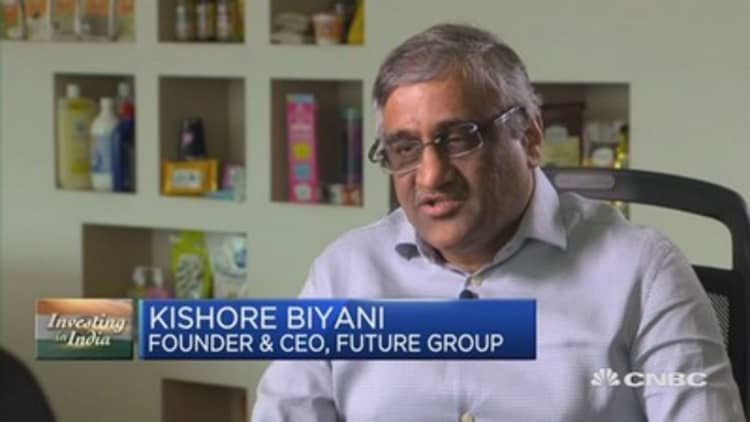
India's burgeoning middle class has long been touted as a consumer gold mine but hasn't always lived up to the hype.
"Over the past decade, India's consumer market has generated plenty of interest among investors, most notably the size of the population, prospects for rapid growth in real incomes and better provision of financial services," Shilan Shah, an India economist for Capital Economics, said in a recent note.
Those factors drove a private consumption surge from 2004-2011, but consumption growth has since slumped and consumer goods import growth is slowing, he said.
At least one analyst says the disappointment may be due, at least in part, to grossly overestimating the size of India's middle class. Analysts have estimated that anywhere from 100 million to 300 million people out of its around 1.2 billion total population can be considered middle class.
But that's just plain wrong, Dheeraj Sinha, author of India Reloaded: Inside India's Resurgent Consumer Market, told CNBC.
"If you look at the census of India, there are about 600 million people in the country who do not have access to pure drinking water and toilets," said Sinha, who also is chief strategy officer at advertising agency Grey, part of the WPP Group, in India.
"There are only 56 million people who have access to cars. So the middle class can not be 300 million in size."
That's not the only reason the market hasn't lived up to the hype, Sinha said, noting that marketers had targeted "cheap" products at Indian consumers. That may be driven in part by the 2004 book The Fortune at the Bottom of the Pyramid, by C.K. Prahalad, which in part urged companies to target low-end consumers in emerging markets with stripped-down products as a way to cash in on the poor's needs.
It's the wrong approach for India's middle class, Sinha said.
"India actually is a market for aspiration and not affordability. So even the bottom of the pyramid, the poor, want sexier products. They want shinier cars, they want shinier mobile phones, they want better-looking apparel," he said. "We need to bring in products and services that make the Indian consumer feel that they are moving up the ladder, rather than going down."
As an example, he compared Samsung, which has done well in India by using its international smartphone lineup, with Nokia, which stumbled by bringing the market "a feature phone for India which pretended to be a smartphone."
The market may have proved more tricky to tap than it first appeared, but some still see great opportunity in India's huge pool of potential consumers.
"It is far from being all doom and gloom," Capital Economics' Shah said. "Even on our more tempered forecasts, we estimate that India's consumer market could be worth nearly $3 trillion by 2030 – more than double current levels."
Homegrown Godrej Group, which offers products ranging from locks to furniture to mosquito repellents, has targeted India's mass market, and sees plenty of sectors still unexploited.
"Consumers in rural India want to buy products which are backed by a reputable brand," Adi Godrej, chairman of the group, told CNBC. "The big opportunity in the developing world and particularly in India is that consumer products are not deeply penetrated, not everybody consumes everything."
Godrej said only three product categories had "fully penetrated" every household in India: soap, detergent and matches.
"Everything else is underpenetrated so we have a great opportunity to get more Indian families using our products over the next decade or two," Godrej said.
That doesn't mean companies - even homegrown ones - don't face some serious headwinds to expanding consumer sales.
Kishore Biyani, the founder and CEO of retailer Future Group, told CNBC that Indians consumption aspirations were growing, which was why he's targeted the food, fashion and home categories.
But he sees some big challenges in the near future.
"We sell nearly close to a 120 million to 130 million garments a year," Biyani said. "We are worried once we grow, where are we going to source this from? We don't have manufacturing capacities in India; we don't have mills which can produce the volumes that we want tomorrow."
Other marketers are by-passing the low-to-middle sector of the consumer market entirely.
"We're always talking about the mass segment in India," advertising strategist and author Sinha said. "(But) the premium in India is a big market."
He noted that high-end automobile brands, such as Audi, BMW and Mercedes, had posted huge jumps in Indian sales even as mid-market brands slowed.
One multi-national company, Rio Tinto, definitely has its eye on the premium market.
Rio Tinto is developing the Bunder diamond project in Madhya Pradesh with hopes of marketing the diamonds to Indians, Alan Davies, CEO of diamonds and minerals at the company, told CNBC.
"When we start Bunder, it'll be Indian diamonds for Indian gift giving. A really winning concept," Davies said.




